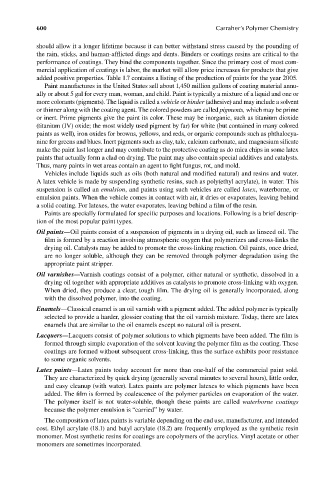Page 637 - Carrahers_Polymer_Chemistry,_Eighth_Edition
P. 637
600 Carraher’s Polymer Chemistry
should allow it a longer lifetime because it can better withstand stress caused by the pounding of
the rain, sticks, and human-afflicted dings and dents. Binders or coatings resins are critical to the
performance of coatings. They bind the components together. Since the primary cost of most com-
mercial application of coatings is labor, the market will allow price increases for products that give
added positive properties. Table 1.7 contains a listing of the production of paints for the year 2005.
Paint manufactures in the United States sell about 1,450 million gallons of coating material annu-
ally or about 5 gal for every man, woman, and child. Paint is typically a mixture of a liquid and one or
more colorants (pigments). The liquid is called a vehicle or binder (adhesive) and may include a solvent
or thinner along with the coating agent. The colored powders are called pigments, which may be prime
or inert. Prime pigments give the paint its color. These may be inorganic, such as titanium dioxide
(titanium (IV) oxide; the most widely used pigment by far) for white (but contained in many colored
paints as well), iron oxides for browns, yellows, and reds, or organic compounds such as phthalocya-
nine for greens and blues. Inert pigments such as clay, talc, calcium carbonate, and magnesium silicate
make the paint last longer and may contribute to the protective coating as do mica chips in some latex
paints that actually form a clad on drying. The paint may also contain special additives and catalysts.
Thus, many paints in wet areas contain an agent to fight fungus, rot, and mold.
Vehicles include liquids such as oils (both natural and modified natural) and resins and water.
A latex vehicle is made by suspending synthetic resins, such as poly(ethyl acrylate), in water. This
suspension is called an emulsion, and paints using such vehicles are called latex, waterborne, or
emulsion paints. When the vehicle comes in contact with air, it dries or evaporates, leaving behind
a solid coating. For latexes, the water evaporates, leaving behind a film of the resin.
Paints are specially formulated for specific purposes and locations. Following is a brief descrip-
tion of the most popular paint types.
Oil paints—Oil paints consist of a suspension of pigments in a drying oil, such as linseed oil. The
film is formed by a reaction involving atmospheric oxygen that polymerizes and cross-links the
drying oil. Catalysts may be added to promote the cross-linking reaction. Oil paints, once dried,
are no longer soluble, although they can be removed through polymer degradation using the
appropriate paint stripper.
Oil varnishes—Varnish coatings consist of a polymer, either natural or synthetic, dissolved in a
drying oil together with appropriate additives as catalysts to promote cross-linking with oxygen.
When dried, they produce a clear, tough film. The drying oil is generally incorporated, along
with the dissolved polymer, into the coating.
Enamels—Classical enamel is an oil varnish with a pigment added. The added polymer is typically
selected to provide a harder, glossier coating that the oil varnish mixture. Today, there are latex
enamels that are similar to the oil enamels except no natural oil is present.
Lacquers—Lacquers consist of polymer solutions to which pigments have been added. The fi lm is
formed through simple evaporation of the solvent leaving the polymer film as the coating. These
coatings are formed without subsequent cross-linking, thus the surface exhibits poor resistance
to some organic solvents.
Latex paints—Latex paints today account for more than one-half of the commercial paint sold.
They are characterized by quick drying (generally several minutes to several hours), little order,
and easy cleanup (with water). Latex paints are polymer latexes to which pigments have been
added. The fi lm is formed by coalescence of the polymer particles on evaporation of the water.
The polymer itself is not water-soluble, though these paints are called waterborne coatings
because the polymer emulsion is “carried” by water.
The composition of latex paints is variable depending on the end use, manufacturer, and intended
cost. Ethyl acrylate (18.1) and butyl acrylate (18.2) are frequently employed as the synthetic resin
monomer. Most synthetic resins for coatings are copolymers of the acrylics. Vinyl acetate or other
monomers are sometimes incorporated.
9/14/2010 3:43:43 PM
K10478.indb 600 9/14/2010 3:43:43 PM
K10478.indb 600

